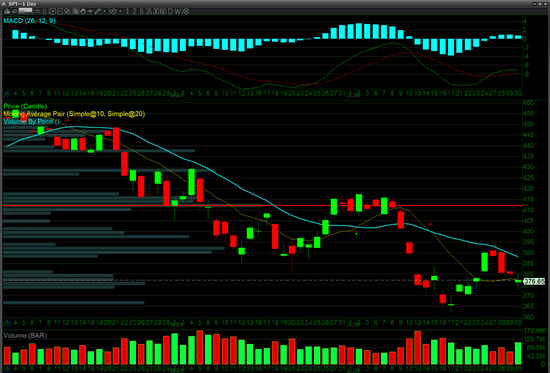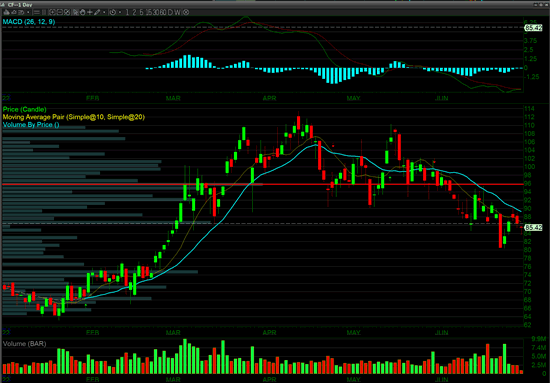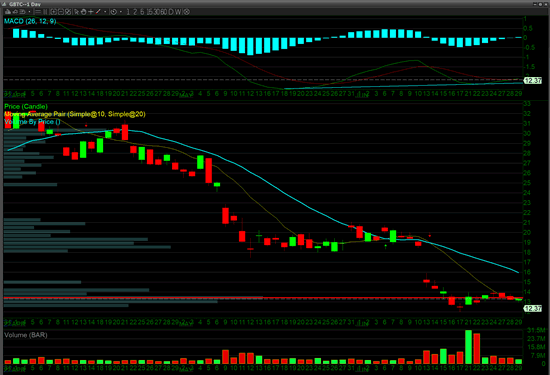Summer Slowdown or Volatility?
What can be expected after another down month and what has been one of the worst annual performances for the U.S. stock markets in over a decade? Volatility will most likely continue as we are about to come into the earnings season. The last few days of June were also the last few days of the second quarter. This often means that fund managers are doing their usual “window dressing” routine. In a down market, stocks will generally rise as hedge funds that were short need to buy to cover those positions as they need to book the profits and get paid. Also, portfolio managers buy the top-performing stocks for the last quarter so that they can show their investors that they were making good investment decisions. This is exacerbated by the timing of the end of the second quarter.
 This $SPY chart illustrates the maturing down trend in the markets.
This $SPY chart illustrates the maturing down trend in the markets.
The market is clearly making lower highs and lower lows up until this point. The market seems to be slowing to the downside which is a positive thing in the short-term. The red line on the chart above illustrates the point of control which the market should return to. The MACD is also decelerating but remains on the positive side of the histogram and the signal lines are moving up off a deeply oversold level.
In June, we had the largest interest rate hike in over a decade. The Federal Reserve Bank raised interest rates by 75 basis points and it’s expected to do the same again at its July meeting. These rate hikes are starting to have an impact on the economy, but have yet to tame the runaway inflation caused by over-stimulus after the worldwide pandemic. When you overstimulate an economy and put more money into people’s hands, those people compete for the same goods and services thus driving up prices; combined with supply chain interruptions which reduce the amount of overall goods and services in the economy, you get the perfect combination that leads to inflation. When the economy starts to slow down it can lead to stagflation which we may be facing in the near future.
How does this relate to the Stock Market?
Some sectors continue to outperform while others have become so inflated that now they can only move down. The markets are already down over 20% since the beginning of the year when they reached their highs. Most likely this summer will be a wide and whippy pause that will refresh the market move down later in the year. This year, we also have the potential for added volatility caused by the U.S. midterm elections. These elections are more important this year as they are expected to overturn the Democratic majority in both the House of Representatives and in the U.S. Senate. (You can learn more about this in our most recent blog.) This would create a locked federal government, with the executive branch being led by a Democrat President and the legislative and judicial branches being dominated by Republicans and Conservatives.
One thing to note: since the advent of the war between Russia and Ukraine, we can expect defense industry stocks to continue to rise. Also, due to the amount of commodities that are residing in Russia, commodity prices in general will continue to rise. Finally, anything to do with agricultural products and fertilizer will also continue to rise as a large percentage of the world’s fertilizer comes from Russia and Belarus. This will cause worldwide shortages which will lead to food commodity price increases.
 $CF is a fertilizer producer. Their stock chart indicates that they are potentially getting ready for the next bull run to the upside, as you can see illustrated by the MACD above. The current price is deeply oversold but is potentially ready to make a move back into positive territory.
$CF is a fertilizer producer. Their stock chart indicates that they are potentially getting ready for the next bull run to the upside, as you can see illustrated by the MACD above. The current price is deeply oversold but is potentially ready to make a move back into positive territory.
Bitcoin and the Crash of Cryptocurrencies
Cryptocurrencies, more specifically Bitcoin, are a new form of asset that are technically not backed by anything, but the value is in the system that they exist on top of. Their value is derived by what people are willing to pay for them. Their only intrinsic value is the value of the network of computers used to mine and process the transactions which store the data and serve as a store of wealth. Some cryptocurrencies, such as Ethereum, had some other use value such as smart contracts and the ability to tokenize and create other cryptocurrencies/tokens. With the markets in full retreat, inflation rising and everything generally costing more than before, people have a great need for their money. Due to this, many people are getting more risk averse and have had good reason to liquidate their digital assets. With the demise of Terra Luna, the potential demise of Celsius, and others, there is a real crisis of confidence relating to cryptocurrencies. No, they’re most likely not going to go away, but in the near-term this new asset class which is highly reliant on technology is going to be far worse off than any of the other asset classes. As a result of that, both Bitcoin and Ethereum have dropped to multi-year lows.
 As you can see in the chart of the $GBTC, bitcoin has practically fallen off of the chart. The one thing that really stands out is that there is a strong divergence between the MACD and the price chart. The MACD is making a higher low that usually indicates a strong reversal to the up side from deeply oversold values.
As you can see in the chart of the $GBTC, bitcoin has practically fallen off of the chart. The one thing that really stands out is that there is a strong divergence between the MACD and the price chart. The MACD is making a higher low that usually indicates a strong reversal to the up side from deeply oversold values.
We hope you have all been heeding our calls for caution over the last six months. This market is great for day traders and options traders. Summer tends to be less active than other times of the year, but there will most likely be volatility this summer to keep both traders and investors occupied.
Research provided by Michael DiGioia, Director of Education
Please note that the U.S. stock market will be closed on Monday (7/4) in observance of Independence Day. The DAS office will also be closed. We will reopen on Tuesday (7/5) for normal office hours (8:30am – 5:30pm ET). Have a safe and enjoyable holiday.
What’s New from DAS
While we didn’t release any production updates during the month of June, we did release iDas version 2.0.1 fo Apple devices. The update is available for free in the Apple App Store. Click here to watch a video that showcases the updated iDas. We are currently re-designing the interface for the Android version to match the Apple device version. There is no release date for that updated version as yet. iDas 2.0.1 includes the following updates:
1. Modified the stop window position.
2. Fixed montage doesn’t save symbols.
3. Position can remember the last account used.
4. Fixed montage config sometimes failed to load the account.
Watch our Streams on YouTube
You can view the most recent newsroom stream here as well as all of our newsroom streams from this link. Also be sure to subscribe to our YouTube channel for educational and trading videos as well as all things DAS! And also be sure to follow us on all major social media platforms by following @dastrader.
If you have any ideas for anything you want to see on our newsroom, please send us an email: newsletter@dastrader.com.



